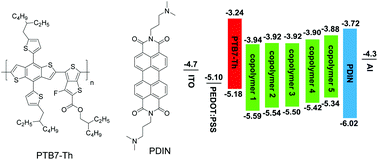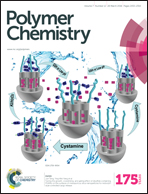Design of three-component randomly incorporated copolymers as non-fullerene acceptors for all-polymer solar cells†
Abstract
A series of randomly arranged donor–acceptor-type copolymers, used as replacements for fullerene-based acceptors in organic solar cells, were synthesized by the Stille coupling copolymerization. The copolymers, PNDI–TT–TVTs, were composed of naphthalene tetracarboxylic diimide (NDI) acceptor units and randomly distributed thieno[3,2-b]thiophene (TT) and thienylene-vinylene-thienylene (TVT) donor units. The effects of the TT-to-TVT ratios on the absorption, energy levels, charge transport, morphology, and performance of the resulting fabricated solar cell devices were investigated. The polymer solar cells fabricated from blends of poly[[4,8-bis[5-(2-ethylhexyl)thiophene-2-yl]benzo[1,2-b:4,5-b′]dithiophene-2,6-diyl][3-fluoro-2-[(2-ethylhexyl)carbonyl]thieno[3,4-b]thiophenediyl]] (PTB7-Th) and PNDI–TT–TVTs (containing 25% of TT and 75% of TVT) displayed a power conversion efficiency of 5.27%, which was significantly higher than those achieved by devices based on alternating arranged copolymers. The current results indicate that random copolymerization is a promising approach to develop novel polymer acceptors for application in organic photovoltaics.


 Please wait while we load your content...
Please wait while we load your content...